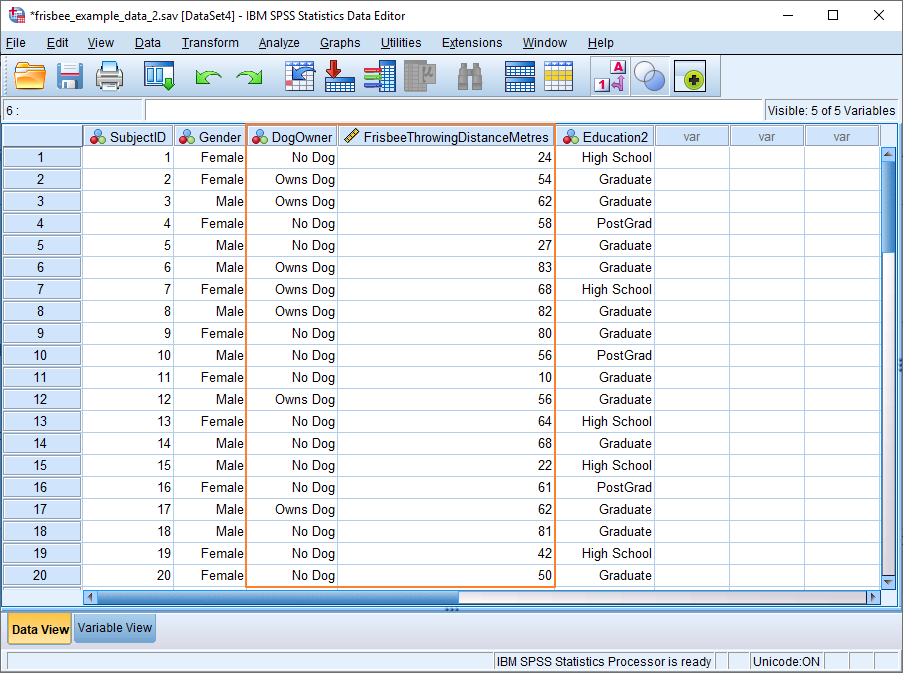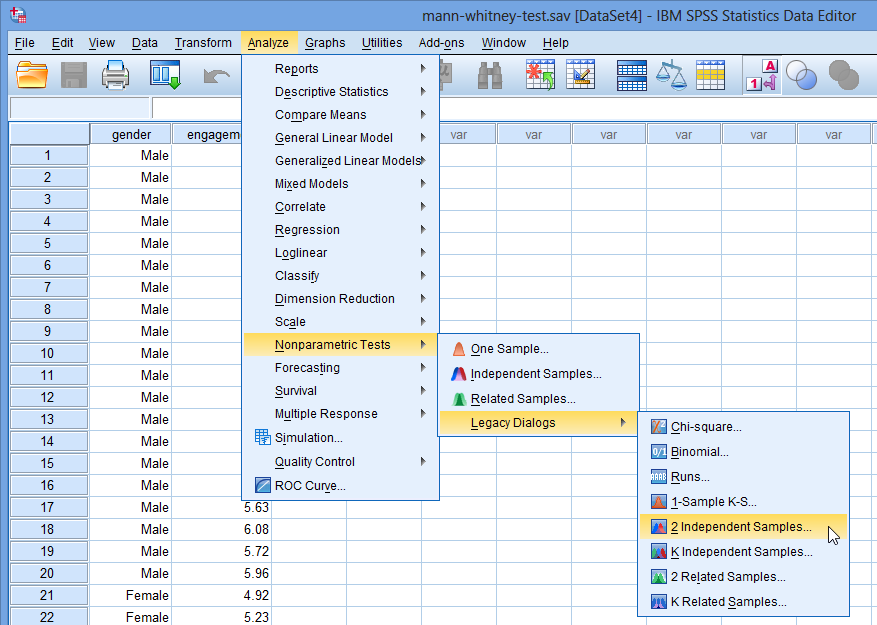
How to do a MannWhitney U Test in SPSS? iLearn Statistics YouTube
The Mann-Whitney U test procedure uses the rank of each case to test whether the groups are drawn from the same population. Mann-Whitney tests that two sampled populations are equivalent in location. The observations from both groups are combined and ranked, with the average rank assigned in the case of ties. The number of ties should be small.

Mann Whitney U Test in SPSS Concept, Interpretation, and Reporting Mann Whitney U Test YouTube
In order to run a Mann-Whitney U test, the following four assumptions must be met. The first three relate to your choice of study design, whilst the fourth reflects the nature of your data: Assumption #1: You have one dependent variable that is measured at the continuous or ordinal level. Examples of continuous variables include revision time.

How to Perform a MannWhitney U Test in SPSS Statology
To conduct a Mann-Whitney U test, we follow the standard five-step hypothesis testing procedure: 1. State the hypotheses. In most cases, a Mann-Whitney U test is performed as a two-sided test. The null and alternative hypotheses are written as: H0: The two populations are equal Ha: The two populations are not equal 2.

How to Perform a MannWhitney U Test in SPSS Statology
The Mann Whitney U test is a nonparametric hypothesis test that compares two independent groups. Statisticians also refer to it as the Wilcoxon rank sum test. The Kruskal Wallis test extends this analysis so that can compare more than two groups. If you're involved in data analysis or scientific research, you're likely familiar with the t-test.

Tutorial Uji Mann Whitney dengan SPSS YouTube
The result of performing a Mann Whitney U Test is a U Statistic. For small samples, use the direct method (see below) to find the U statistic; For larger samples, a formula is necessary. Or, you can use technology like SPSS to run the test. Either of these two formulas are valid for the Mann Whitney U Test. R is the sum of ranks in the sample.

Reporting MannWhitney U Test in SPSS
Select an appropriate adjective to compare the two groups in your study, e.g., higher, lower, greater, faster, etc. (3) Report the value of Mann-Whitney U from the Test Statistics table in the SPSS output to two decimal places. (4) The value of z for a Mann-Whitey U test in the Ranks table of the SPSS output will always be negative.

MannWhitney U Effect Size (SPSS) YouTube
This video demonstrates how to carry out the Mann-Whitney U test using SPSS. I also discuss the difference between this test and the standard parametric inde.

How to Perform a MannWhitney U Test in SPSS Statology
The Mann-Whitney test can be considered a possible alternative to the parametric independent samples t-test when certain distributional assumptions (e.g., normality) are not met for that test..

Prueba U de MannWhitney en SPSS, incluida la interpretación Tutorial gratuito de Excel en
The Mann-Whitney U test is used to compare differences between two independent groups when the dependent variable is either ordinal or continuous, but not normally distributed.

How to perform the Mann Whitney test using SPSS (Feb 2021) YouTube
The Mann-Whitney U test is a popular test for comparing two independent samples. That is to say, It is a nonparametric test, as the analysis is undertaken on the rank order of the scores and so does not require the assumptions of a parametric test. ( Source) The Mann-Whitney U test is a nonparametric test (data are not normally distributed).

How to Perform a MannWhitney U Test in SPSS Statology
A Mann-Whitney U test (sometimes called the Wilcoxon rank-sum test) is used to compare the differences between two samples when the sample distributions are not normally distributed and the sample sizes are small (n <30). It is considered to be the nonparametric equivalent to the two sample t-test.

MannWhitney U test in SPSS Laerd Statistics Premium Sample
Mann-Whitney U Test - SPSS (UPDATED) how2stats 85.6K subscribers Subscribe Subscribed 1.4K Share 294K views 7 years ago I perform and interpret a Mann-Whitney U test in SPSS. I describe how.

How to Use SPSS MannWhitney U Test YouTube
Mann-Whitney in SPSS sample size is 40 or less, an Exact test is performed automatically and another row appears in the output entitled "Exact Sig. [2*(1-tailed Sig.)]" which is the p-value that should be used. Here the sample size is large so the Z approximation p-value of 0.017 should be used. Reporting a Mann-Whitney test A Mann-Whitney.

MannWhitney U Test SPSS (UPDATED) YouTube
1. Objective. Select Customize analysis. Fields. Either use the default Use predefined roles or select Use custom field assignments and send Bone Density Measurement to the Test Field box and Sex to the Groups box.) 3. Settings. Select Customize tests, then. Mann-Whitney U (2 samples) in the.

Advanced Stats with SPSS Mann Whitney U Test effect size (eta squared)
Step 3: Interpret the results. Once you click OK, the results of the Mann-Whitney U Test will be displayed: The most important numbers in the output are the Z test statistic and the Asymptotic 2-tailed p-value: Since the p-value is not less than 0.05, we fail to reject the null hypothesis.

MannWhitney U in SPSS YouTube
The Mann-Whitney U Test evaluates whether two samples are likely to originate from the same underlying population, and it tends to be used in situations where an independent-samples t test is not appropriate (for example, if either of the sample distributions are non-normal). Quick Steps